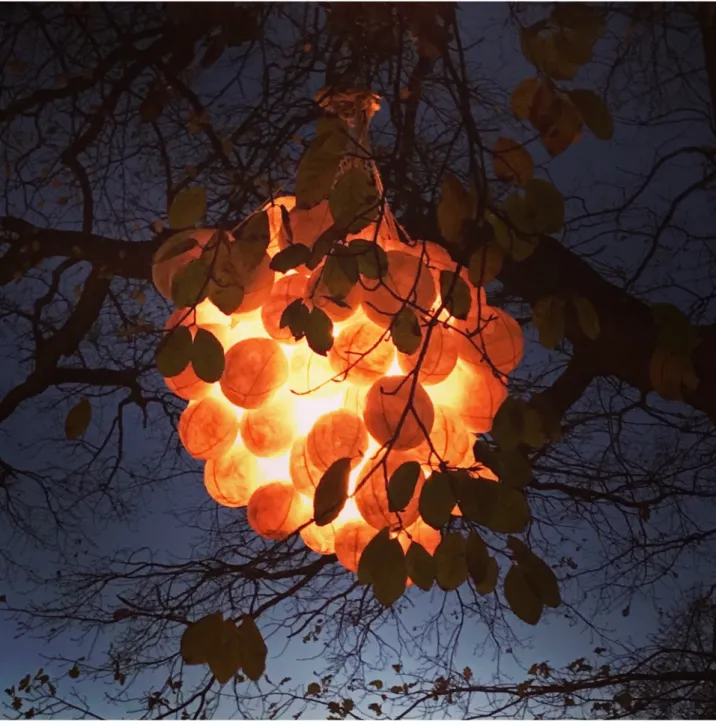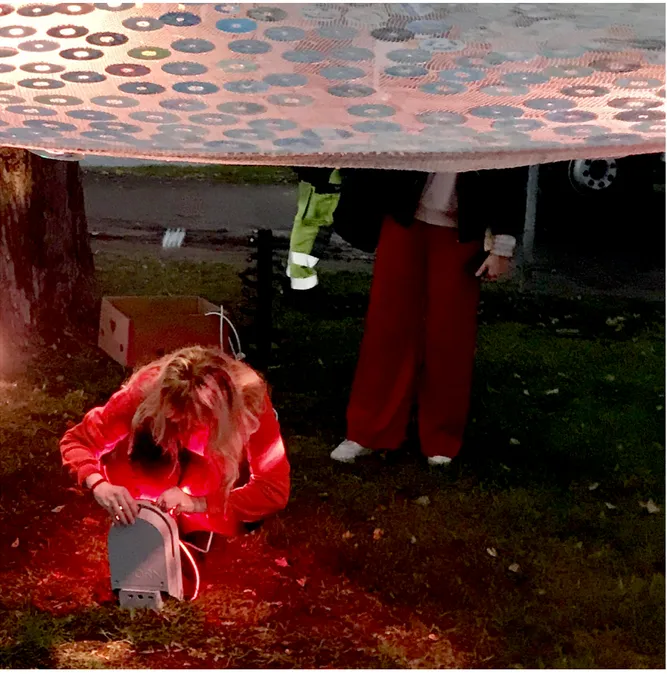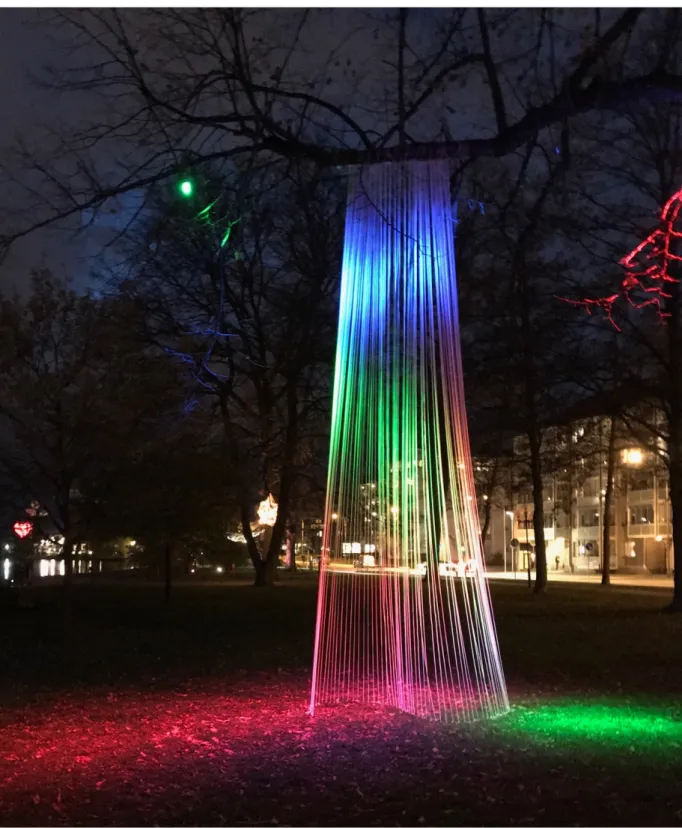Learning via “Nattljus” 2018
A report on co-creation and learning in Spatial Design-Information Design
education, developed as part of the activities produced in conjunction with
Mälardalen University Living Lab.
Figure 1. ”In Unity” by Martina Antonino, Elin Bergström, Tina Knuutinen, Ricardo Mejia Ramirez and Sara Söderman.
Learning via “Nattljus” 2018
Authors: Ulrika Florin & Esko Mäkelä
Abstract
Learning via “Nattljus” 2018 reports an example of co-creation and learning, developed as part of the activities produced in conjunction with MDH Living Lab in 2018. This project was designed as an integrated part of the Bachelor’s course Ljus och ljud (Light and Sound), 7.5 credits, that was given at Mälardalen University in the autumn. The project was initiated by Eskilstuna Municipality and is a part of the biennial light festival, running for its third time. The collaboration included a LED light specialist company from Stockholm, Zumbotel Group, the Municipality of Eskilstuna and an independent external light designer with connections to KTH (the Royal Institute of Technology). The methods for the collaborative project were mainly practical, based on workshops and labs in a studio environment, as well as on site. It was mixed with experience-based lectures given by external experts: from the municipality, the lighting company and a light designer, this was iterated with integrated design and theory lectures on site, by the course leader and the involved researcher, connected to MDH LL.
This led to a comprehensive integration of the course content and practice-driven processes enabling collaborative learning in a real setting that information designers with spatial design skills might encounter in their coming professional lives.
Context, project and planning
The design of the co-creation project “Nattljus” was an integrated part of the Bachelor’s course Ljus och ljud ,7.5 credits (Light and Sound). The course is run within the Bachelor’s programme Spatial Design-Information Design within the department of Information Design (ID) at the School of Innovation, Design and Engineering (IDT) at Mälardalen University (MDH) in collaboration with MDH Living Lab.
The main stakeholders involved in the project were the students, the course coordinator and Eskilstuna Municipality. Additional stakeholders were the international lighting company Zumtobel, the light designer Viktorija Misiunaite (Master of Light Design from the Royal Institute of Technology) and staff from the Municipality and the University.
The project was initiated by Eskilstuna Municipality as a part of the biennial light festival that ran for its third time in the autumn 2018. Students from MDH also took part in the two
previous festivals, but in the Nattljus festival 2018, the group of students from Spatial Design-Information Design were specially invited as full participants, on a par with domestic and international light artists.
All planning was conducted in close collaboration with the Project Manager Karin Stolt (Landscape Architect) from Eskilstuna Municipality, Light Designer Viktorija Misiunaite and Light Engineer Martin Kippel from the Zumtobel Group. The Course Coordinator Esko Mäkelä was the one mainly responsible for the contacts with stakeholders and the design of pedagogical aspects, with relation to learning objectives and examination goals, as well as the overall planning.
Concerning the research aspects, a close collaboration with Ulrika Florin, who works with MDH Living Lab in research-related questions, and involves design and co-creation aspects in her research, but also as Programme Coordinator for Spatial Design-Information Design which means overview of progression and of the building relations, in this case long-lasting relations with the Municipality, and specifically the City Planning and Development sections. This made it possible for our students to give reflective talks about their suggested designs and the processes in a public dialogue forum, arranged by the Municipality´s Planning Section at the Munktell Sience Park, in connection with the inauguration.
Learning by creating – gaining from each other’s experience
To create together with professionals with different competence, means a meeting between different practical knowledge communities. And, as Etienne Wenger emphasises, practical knowledge communities share identification, connection and meaning; they share
experiences, perceptions and commitment and participate in the ongoing adjustments of the knowledge, which means that a continuous learning is ongoing, both individually and collectively.1 This is one way to explain the benefits, for both students and teachers, of this working-together-style of learning, including external actors, in the format of a university curriculum course. Learning in the “Nattljus” project was for the most part a sociocultural activity.2 Since it was situated in both the IDT Department Black Box Studio and on the actual light festival site the students expanded their zone of proximal development. Using light as a communicative mediation reached out beyond the limitation of a mere
enclosed situation to face a real open-air event with hundreds of visitors daily.
1Wenger, Etienne (1998/2008), Communities of Practice: Learning, Meaning and Identity, Camebridge University
Press, 18:e utgåvan 2008, s.107; Florin, U. (2015). Konstnärskap i samspel: om skapande arbetsprocesser i
myndighetsledda samverkansprojekt (PhD dissertation). Mälardalen University, Västerås. 2 Vygotskij, Lev (1978) Mind in Society. Cambridge, Mass.: Harvard U.P.
Real collaboration –opportunity to evaluate on the go
The most important impact happened on two significant levels: one was the collective lessons learnt via the “real” case, with collaboration and co-production that included skilled representatives of future professional lives as designers, representing both the Municipality and commercial organisations; the other was the students’ opportunity to build their
individual portfolios and CVs (that also goes for Spatial Design-Information Design as a whole).
Continued course development, as such, also benefitted from the collaboration, and the course has now been altered to fit future collaboration and co-production, including how to handle examination goals and mutual learning for all involved, which in fact is far developed to meet the preparation for the upcoming Light & Sound course starting in the autumn 2019.
Follow up and Impact
The Nattljus light festival has been a biennial event since 2016. In the first two years much of the collaboration with educational organisations was directed towards the Master’s
programme in Light Design at the Royal Institute of Technology (KTH) in Stockholm. In the 2018 festival, collaboration with KTH came to an end, and students from MDH were accepted as full participants. This led to a comprehensive integration of course content and practice-driven processes enabling collaborative learning of, in, with and about real situations that an Information/Spatial design worker might encounter in professional contexts.
The methods for the collaborative project were mainly practice-based laboratory experiments and workshops in the MDH Studio, in sequence with lectures, in general given by the external partners: from the Municipality, the lighting company and light designer. Conducted on-site-workshops served as inspiration for future projects, thus developing the course content. The light festival and student participation gained considerable interest from the public and media. Studio-Based learning as a creative method in design education has been developed at
Harvard Project Zero.3 The Light and Sound course is constructed so as to make use of the workshop resources at MDH, integrating practical knowledge and cognitive processes in
situated(?) studio methodology. This entails student participation on multiple levels. The creative work and outcome are evaluated and assessed in collaboration with students. Continuous assessment and rethinking support the ability to design and develop a creative product of any kind.4
4 Cowdry, R. and de Graff, E. (2005). Assessing highly-creative ability. Assessment and Evaluation in Higher Education 30(5), 507–518.
“Nattljus” Portfolio
Figures 1-4. Top and bottom left “Strings Attached” (Sara Adriansson, Gazang Aziz, Ida Cardestål, Cajsa Mikaelsson, Maria Vilmunen Pizarro, Celina Vu). Top right “In Unity” (Martina Antonino, Elin Bergström, Tina Knuutinen, Ricardo Mejia Ramirez, Sara Söderman). Bottom right “The Butterfly Effect” (Anna Carlén, Alicia Fundberg, Fanny Gustafsson, Mathilda Jensen, Sara Meijer Lönnroth, Denice Berg Råholm).
Figure 5. “Tillsammans” (Mari Hallström, Madelene Hellström, Eva Lindblom, Marie Pierre Massamba, Martina Oscarsson, Sofie Östlund)
Figure 6. “Strings Attached“ (Sara Adriansson, Gazang Aziz, Ida Cardestål, Cajsa Mikaelsson, Maria Vilmunen Pizarro, Celina Vu).
References
Florin, U. (2015), Konstnärskap i samspel: om skapande arbetsprocesser i myndighetsledda samverkansprojekt (PhD dissertation). Mälardalen University, Västerås.
Cowdry, R. and de Graff, E. (2005). Assessing highly- creative ability. Assessment and Evaluation in Higher Education 30(5), 507–518.
Harvard Project Zero, http://www.pz.harvard.edu, retrieved 2019-09-04.
Wenger, E. (1998/2008), Communities of Practice: Learning, Meaning and Identity, Cambridge University Press, 18:e utgåvan (18th edition?)2008.


